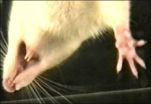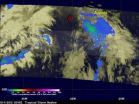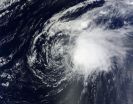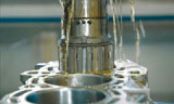(Press-News.org) Nausea is a common and distressing side effect of many drugs and treatments. Unlike vomiting, nausea is not well understood, but new research by University of Guelph scientists may soon change that.
Guelph PhD student Katharine Tuerke, neuroscience researcher Cheryl Limebeer and Prof. Linda Parker in the Department of Psychology believe they've found the mechanism in the brain that is responsible for the sensation of nausea – with the help of some "disgusted" rats.
Their study was published this week in Journal of Neuroscience.
"Although everyone has experienced nausea at some point, its neurobiology is poorly understood due to a lack of animal models," said Parker, who holds the Canada Research Chair in Behavioural Neuroscience.
"We know about vomiting. The vomiting reflex is very well characterized, but the experience of nausea is something that little is known about. How is it generated? Where is it generated?"
Although rats can't vomit, they do display a disgust reaction called gaping when re-exposed to a taste that made them feel nauseous in the past. Therefore, these gaping reactions in rats provide a model to understand brain mechanisms that produce nausea in humans.
Using this gaping model, the Guelph researchers, along with University of Toronto professor Paul Fletcher, discovered that serotonin release in the visceral insular cortex may be responsible for the sensation of nausea.
The insular cortex is a site of taste and illness input in the brain. Based on its cell structure and inputs, the insular cortex can be divided into two regions: the gustatory insular cortex and the visceral insular cortex. The gustatory insular cortex receives taste input and the visceral insular cortex receives input from regions of the gut that may produce the sensation of nausea.
Previous research has shown that the neurotransmitter serotonin is critical for the production of nausea. Indeed, classic anti-emetic drugs such as ondansetron that are used in chemotherapy treatment are drugs that block the action of a type of serotonin receptor, serotonin-3 receptors.
The researchers first demonstrated that depletion of serotonin in the entire insular cortex prevented the nausea-induced gaping reactions in rats, suggesting that serotonin activation in this region is necessary for the production of nausea.
Next they examined the effects of delivering drugs that either activate serotonin-3 receptors or block serotonin-3 receptors to specific regions of the insular cortex. In the visceral insular cortex, but not the gustatory insular cortex, activating serotonin caused nausea (produced gaping reactions) and blocking serotonin reduced nausea (eliminated gaping reactions).
These data suggest that the activation of the visceral insular cortex by serotonin may be responsible for the production of the elusive sensation of nausea, which is so difficult to treat.
Tuerke and Parker hope their work will lead to a better understanding of basic neural processes affected by prescribed drugs, with specific applications to controlling nausea and vomiting caused by cancer chemotherapy.
INFORMATION:
The research was supported by the Natural Sciences and Engineering Research Council of Canada.
'Disgusted' rats teaching scientists about nausea, work may lead to new cancer treatments
2012-10-05
ELSE PRESS RELEASES FROM THIS DATE:
Tree nut research may unexpectedly lead to medical advances
2012-10-05
This press release is available in Spanish.
Prescription drugs that today help patients fight severe fungal infections might tomorrow be even more effective, thanks to unexpected findings from agriculture-based, food-safety-focused studies by U.S. Department of Agriculture (USDA) scientists and their colleagues.
Petri-dish experiments conducted by now-retired USDA Agricultural Research Service (ARS) research leader Bruce C. Campbell, ARS molecular biologist Jong H. Kim, and their co-investigators suggest that pairing conventional antifungal medicines with natural, edible ...
NASA notes Nadine now no more
2012-10-05
Twenty-three days after Nadine was born, the tropical cyclone's life came to an end in the northeastern Atlantic Ocean. NASA's TRMM satellite caught a look at the fading Nadine one final time on Oct. 3 before it dissipated.
NASA's Tropical Rainfall Measuring Mission (TRMM) satellite passed above long-lasting Nadine for the last time before the tropical storm's dissipation on October 4, 2012 at 0249 UTC (10:49 p.m. EDT October 3, 2012).
TRMM measures rainfall from space and there was very little remaining in Nadine when it passed overhead. Rainfall data from TRMM's Microwave ...
NASA satellites indicate wind shear taking toll on Oscar
2012-10-05
Satellite data is showing that northwesterly wind shear is taking a toll on Tropical Storm Oscar in the central Atlantic and it is expected to dissipate the storm late on Oct. 5, 2012.
NASA's Aqua satellite passed over Tropical Storm Oscar on Oct. 4 at 1335 UTC (9:35 a.m. EDT) and the Moderate Resolution Imaging Spectroradiometer (MODIS) instrument captured a true-color image of the storm. The imagery showed bulk of Oscar's clouds and showers were southeast of the center of circulation as a result of wind shear.
On Oct. 5 at 5 a.m. EDT, Oscar's maximum sustained winds ...
Scratching the surface: Stanford engineers examine UV effects on skin mechanics
2012-10-05
Reinhold Dauskardt, PhD, of Stanford's Department of Materials Science and Engineering has been studying skin for years. But when he sent his students to look for data on the mechanical properties of skin, they came back empty-handed. A lot was known about skin structure and disease, but few papers actually talked about its mechanical function – its ability to stretch and resist tension without tearing. "That motivated us to get more interested in the skin itself," said Dauskardt.
He and his team, including Ph.D. student Krysta Biniek and postdoctoral researcher Kemal ...
Using less gas and oil to get where you're going
2012-10-05
An engine without oil will not survive for very long. Pistons need plenty of lubricant in order to be able to move within the cylindrical sleeves in the engine block. Two things are known to raise the resultant level of friction. The first is attributed to distortion of the cylindrical bore hole when the cylinder head is attached, which is known as static distortion. The second occurs when the engine is running and temperatures warp the bore hole. The extent of this thermal distortion depends on prevailing engine temperatures and the specific engine model. In reality, the ...
Origin of ultra-fast manipulation of domain walls discovered
2012-10-05
An international team of researchers has found at the free electron laser FLASH a surprising effect that leads in ferromagnetic materials to a spatially varying magnetization manipulation on an ultrafast timescale. This effect could be the key to further miniaturization and performance increase of magnetic data storage devices. From Mainz, the group of Professor Dr. Mathias Kläui from the Institute of Physics at Johannes Gutenberg University Mainz and in particular Felix Büttner, a member of the Graduate School of Excellence "Materials Science in Mainz", were involved. ...
Testing can be useful for students and teachers
2012-10-05
Pop quiz! Tests are good for: (a) Assessing what you've learned; (b) Learning new information; (c) a & b; (d) None of the above.
The correct answer?
According to research from psychological science, it's both (a) and (b) – while testing can be useful as an assessment tool, the actual process of taking a test can also help us to learn and retain new information over the long term and apply it across different contexts.
New research published in journals of the Association for Psychological Science explores the nuanced interactions between testing, memory, and learning ...
Weather-making high-pressure systems predicted to intensify
2012-10-05
DURHAM, N.C. -- High-pressure systems over oceans, which largely determine the tracks of tropical cyclones and hydrological extremes in much of the northern hemisphere, are likely to intensify this century, according to a Duke University-led study.
The study, published online this week in Nature Geoscience, suggests that as summertime near-surface high-pressure systems over the northern Pacific and Atlantic oceans strengthen, they could play an increasingly important role in shaping regional climate, particularly the occurrence of drought and extreme summer rainfall ...
Get with the computer program
2012-10-05
Montreal, October 5, 2012 – From email to Twitter, blogs to word processors, computer programs provide countless communications opportunities. While social applications have dominated the development of the participatory web for users and programmers alike, this era of Web 2.0 is applicable to more than just networking opportunities: it impacts education.
The integration of increasingly sophisticated information and communication tools (ICTs) is sweeping university classrooms. Understanding how learners and instructors perceive the effectiveness of these tools in the ...
There's no place like home -- For dialysis
2012-10-05
Highlights
Home hemodialysis could allow patients to enjoy increased freedom, quality of life, greater ability to travel, and tangible health improvements.
Increased physician and patient education can eliminate barriers to home hemodialysis and increase its use.
Approximately 2 million patients in the world receive some sort of dialysis treatment.
Washington, DC (October 4, 2012) — Most patients with chronic kidney disease who undergo hemodialysis put up with a grueling treatment regimen that involves going into a clinic several days a week and sitting through a ...



